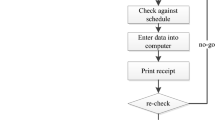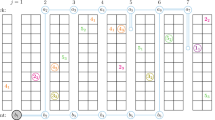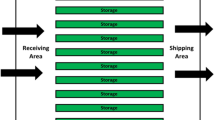Abstract
This paper proposes a methodology to design production strategy considering the cutting peak demand of electricity in shipyard using the discrete event simulator and technique of genetic algorithm. First, the proposed methodology defines an organization model, product model, constraints and production strategy. The organization model is composed of workers and facilities that are defined by their amount of skill, cost and electricity consumption. The product model is defined by workflow. Work plan is calculated by a discrete event simulator that considers the constraints of electricity and work area size. The production strategy consists of the weights of nine dispatching rules. In the developed process simulator, simulation results change according to the parameters of the production strategy. In addition, an adequate production strategy is designed automatically using this process simulator and a random key-based genetic algorithm for minimizing the total cost in performing all activities. This proposed methodology was applied to several sample scenarios of assembly planning considering the cutting peak demand of electricity in shipyard. Results show that this methodology can construct a work plan that will help cut the peak demand of electricity by adequately changing the production strategy. Furthermore, this methodology also evaluates the organizational performance of the change of production strategy while considering the difference of work area size.











Similar content being viewed by others
References
Evans JR, Dean JW Jr (2002) Total quality management, organization, and strategy, 3rd edn. South-Western College Pub
Hattan M, Ichikawa K, Kokubun M (1994) Task-oriented QC application case stories: new challenges for the QC circle. JUSE Press Ltd, Tokyo
IBM, “FileNet Business Process Manager”, http://www-01.ibm.com/software/data/content-management/filenet-business-process-manager/simulator.html
Jin Y, Levitt RE (1996) The virtual design team: a computational model of project organizations. Comput. Math. Organ. Theory 2(3):171–196
Kunz JC, Christiansen TR, Cohen GP, Jin Y, Levitt RE (1998) The virtual design team: a computational simulation model of project organizations. Commun Assoc Comput Mach (CACM) 41(11):84–91
Lankhorst MM (2004) Enterprise architecture modeling: the issue of integration. Adv Eng Inform 18(4):205–216
Suzuki Y, Yahyaei M, Jin Y, Koyama H, Kanga (2012) Simulation based process design: modeling and applications. Adv Eng Inform 26(4):763–781
Moser BR (2012) The design of global work: simulation of performance including unexpected impacts of coordination across Project Architecture, PhD thesis, The University of Tokyo
Hai R, Theißen M, Marquardt W (2011) An ontology based approach for operational process modeling. Adv Eng Inform 25(4):748–759
Brown R, Recker J, West S (2011) Using virtual worlds for collaborative business process modeling. Bus Process Manag J 17(3):546–564
Tyson RB (2001) Applying the design structure matrix to system decomposition and integration problem: a review and new directions. IEEE Trans Eng Manag 48(3):292–306
Unger D, Eppinger S (2011) Improving product development process design: a method for managing information flows, risks, and iterations. J Eng Des 22(10):689–699
Luh PB, Liu F, Moser B (1999) Scheduling of design projects with uncertain number of iterations. Eur J Oper Res 113(3):575–592
Levitt RE, Thomsen J, Christiansen TR et al (1999) Simulating project work processes and organizations: toward a micro-contingency theory of organizational design. Manag Sci 45(11):1479–1495
Kaji K, Tanaka K, Nanno M, Miyamura Y, Shibata K, Zhang J, Miyata H (2010) Specification design of renewable energy management system for recovery planning of a Japanese coastal community after a tsunami disaster. In: Proceedings of 19th ISPE international conference on concurrent engineering, vol 1, pp 51–62
Kajiwara H (2010) Max-plus approach to scheduling problems of block assembly lines. Proc Int Conf Mar Technol 1:189–194
Kajiwara H, Hitoi Y, Nakao Y (2009) Max-plus-algebra based scheduling of a ship building line. Proc Int Conf Comput Appl Shipbuild 1:149–155
Hassan K, Kajiwara H (2013) Application of pull concept-based lean production system in the ship building industry. J Ship Prod Design 29(3):105–116
BPMN ver1.0. (2004) http://www.diveintobpm.org/
Blackstone JH, Phillips DT, Hogg GL (1982) A state-of-the-art survey of dispatching rules for manufacturing job shop operations. Int J Prod Res 20(1):27–45
Hartmann S (1998) A competitive genetic algorithm for resource-constrained project scheduling. Nav Res Logist 45(7):733–750
Kolisch R, Hartmann S (2006) Experimental investigation of heuristics for resource-constrained project scheduling: an update. Eur J Oper Res 174(1):23–37
Merkle D, Middendorf M, Schmeck H (2002) Ant colony optimization for resource-constrained project scheduling”. IEEE Trans Evol Comput 6(4):333–346
Bean JC (1994) Genetics and random keys for sequencing and optimization. ORSA J Comput 6:154–160
Author information
Authors and Affiliations
Corresponding author
About this article
Cite this article
Mitsuyuki, T., Hiekata, K. & Yamato, H. Design of production strategy considering the cutting peak demand of electricity in the shipbuilding industry. J Mar Sci Technol 19, 425–437 (2014). https://doi.org/10.1007/s00773-014-0261-6
Received:
Accepted:
Published:
Issue Date:
DOI: https://doi.org/10.1007/s00773-014-0261-6




